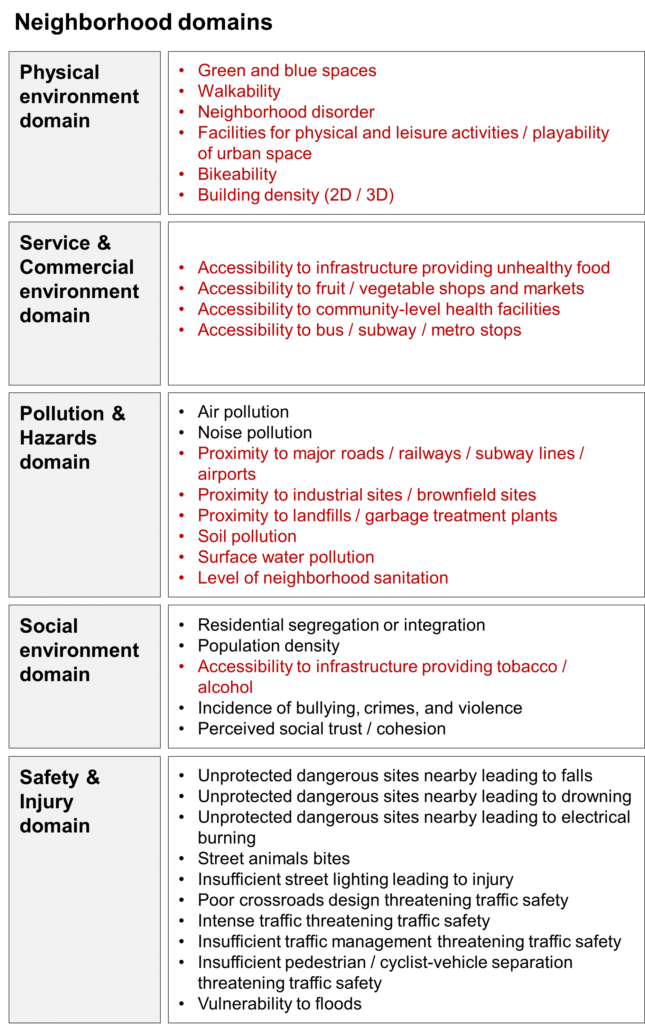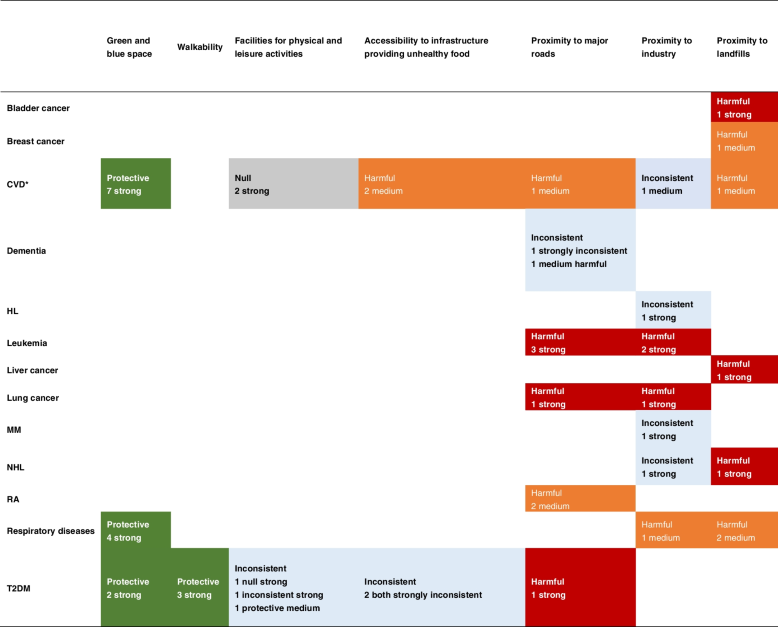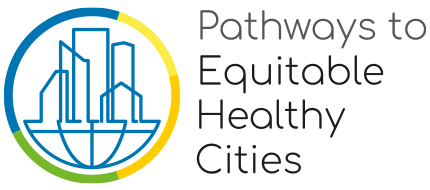Written by: Yuyang Zhang
Urban population exceeded 55% of the world total in 2019 and continues to increase, making the impact of urban environments on human health a growing concern. Neighborhoods are the basic geographical unit of a city and the most appropriate to predict residents’ daily activities and exposure to the urban environment. Colleagues in the Housing and Neighborhood working group developed a list of 5 neighborhood environment domains containing 33 uniformly defined risk factors (Fig.1), including physical environment, service and commercial environment, pollution and hazards, social environment, and safety and injury domains. These were determined after nearly a year of regular discussions in workshops.

Fig 1 The list of neighborhood risk factors, where the risk factors in red are related to infrastructure and further studied in this meta-review.
Why we focused on neighborhood infrastructure?
Neighborhood infrastructure includes physical facilities that sustain people’s lives and work, such as parks, roads, and shops. However, the decay of many city parks and neighborhoods has made them unusable and prone to criminal activity. These issues can only be resolved through changes in government priorities and investments, or social mobilization to preserve and maintain. Improving infrastructure is crucial in urban planning and policy, requiring substantial annual investments to reduce neighborhood inequality. Therefore, identifying relevant risk factors and prioritizing those with poorer conditions for improvement is necessary. Assessing the benefits of infrastructure improvement to neighborhood health can also support lobbying for increased public investment.
Which neighborhood infrastructure matters?
Thus, our aim was to find the neighborhood infrastructure risk factors with sufficient health effects, starting from chronic non-communicable diseases (NCDs), which are the leading causes of death globally. We identified 17 neighborhood infrastructure risk factors from the list, which are shown in red in Figure 1.
Regarding the huge number of neighborhood infrastructure related risk factors and NCD outcomes pairs, this study adopted the method of meta-review to comprehensively review the evidence on the health impacts of these risk factors. Meta-reviews (or “review of reviews”) provides a suitable method to comprehensively assess many neighborhood infrastructure related risk factors since there has been a high volume of systematic reviews and meta-analyses that focused on neighborhood risk factor/human health outcome pairs.
We searched the following four databases for articles from January 2000 to May 2021 on June 15, 2021: Web of Science, PubMed, OVID, and Cochrane library. Only systematic reviews and meta-analyses were included in this meta-review. Important, since the quality of the review differs from the quality of the evidence, we separately assessed the quality of reviews and evidence. Finally, a total of 33 moderate and high-quality reviews were included in the analysis. Seven major NCD outcomes were found to be associated with neighborhood infrastructure related risk factors (Fig. 2). A total of 19 pairs were confirmed to be with definitive health effect and 1 pair confirmed to have no association. Green and blue spaces or walkability had protective effects on human health. On the contrary, proximity to major roads, industry and landfills can pose serious threats to human health. Inconsistent results existed for four neighborhood risk factors, including facilities for physical and leisure activities, accessibility to infrastructure providing unhealthy food, proximity to industry, and proximity to major roads.
Implications for neighborhood infrastructure policy
Our findings provide some implications for neighborhood infrastructure policy.
- New hazardous industries and waste landfills should not be built in densely populated urban areas.
- Established industries should be surrounded by a wide greenbelt with tall trees to attenuate air pollution.
- Highly polluted industries and large waste landfills in densely populated areas should be immediately moved to peri-urban areas.
- New major roads should have a wide greenbelt distance from buildings alongside them.
- Existing major roads should have more and higher road-adjacent trees and sound-deadening shields to reduce traffic-related air pollution, noise, and heat island effect.
- Parks and green infrastructures promoting physical activities should be restricted near harmful infrastructures such as polluted industries, landfills, and major roads.
- Increasing urban green space coverage is important, and green morphology variables such as shape and aggregation index should be considered.

Fig 2. Summary of evidence from included reviews
